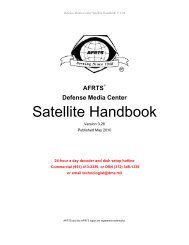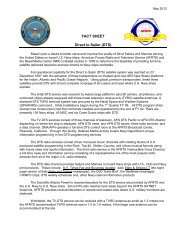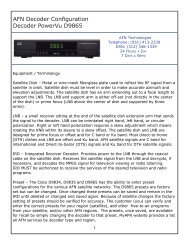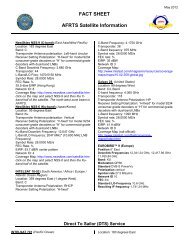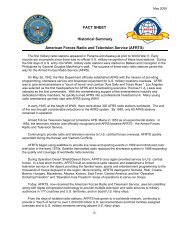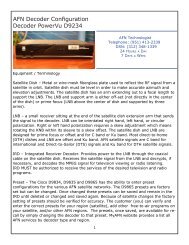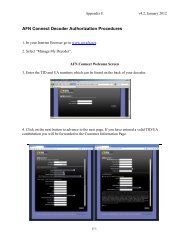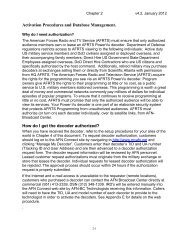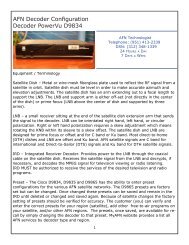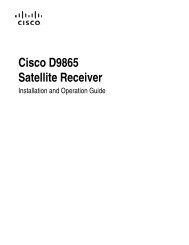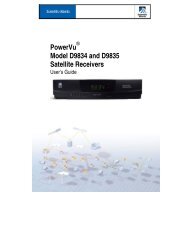Digital Satellite Downlink Reception - American Forces Radio and ...
Digital Satellite Downlink Reception - American Forces Radio and ...
Digital Satellite Downlink Reception - American Forces Radio and ...
You also want an ePaper? Increase the reach of your titles
YUMPU automatically turns print PDFs into web optimized ePapers that Google loves.
Defense Media Center <strong>Satellite</strong> H<strong>and</strong>book V.3.26<br />
Polarization<br />
There are four polarities most common to communications satellites in orbit<br />
today. These are horizontal, vertical, left <strong>and</strong> right h<strong>and</strong> polarization <strong>and</strong> your<br />
system pickup probe must be aligned accordingly for best reception. There are<br />
several different types of feeds: some will need to be manually polarized <strong>and</strong><br />
some will not depending on the type of feedhorn used. This adjustment is best<br />
accomplished while monitoring the satellite signal on the display of a spectrum<br />
analyzer. If a spectrum analyzer isn’t available, make this adjustment <strong>and</strong><br />
maximize the BER of the receiver. Rotate the feedhorn until you begin to see the<br />
other polarization. Turn your receiver on <strong>and</strong> look at the BER. You will notice that<br />
it gets worse as the other polarity begins to increase. The idea is to minimize the<br />
other polarization <strong>and</strong> at the same time maximize the BER or signal quality of<br />
your receiver. If you notice that rotating the feedhorn in a 360 o rotation makes no<br />
difference to the BER/Signal quality. This indicates that your feedhorn is not<br />
adjustable <strong>and</strong> is factory set to the polarization of the satellite transponder <strong>and</strong> no<br />
further adjustments are necessary.<br />
Qualification of <strong>Satellite</strong> Terminals for <strong>Digital</strong> <strong>Reception</strong><br />
The following three subsections include lists of equipment needed to receive the<br />
AFRTS signal. The boxes cover equipment for SATNET C-b<strong>and</strong>, SATNET Kub<strong>and</strong><br />
<strong>and</strong> Television-Direct to Sailor (TV-DTS) C-b<strong>and</strong> digital reception.<br />
Equipment needed for SATNET C-b<strong>and</strong> reception<br />
1. Dish Size: 4.5 meter (minimum size)<br />
2. Mid-b<strong>and</strong> Gain: 43.6 dBi<br />
3. Feedhorn<br />
3.1. For Domestic Region (IntelSat Americas-5) C-b<strong>and</strong> Linear<br />
Vertical Polarization (V)<br />
3.2. For Atlantic Ocean Region: C-b<strong>and</strong> Right H<strong>and</strong> Circular<br />
Polarization (RHCP)<br />
3.3. For Pacific Ocean Region: C-b<strong>and</strong> Left H<strong>and</strong> Circular<br />
Polarization (LHCP)<br />
4. Low Noise Block (LNB)<br />
4.1. Noise Temperature: 25 K (+ -) 5 K<br />
4.2. LO Stability: 1,000 kHz (+ -) 100 kHz<br />
4.3. Recommend using a NORSAT Model 8525F<br />
5. Cable: RG-6 or RG-11<br />
6. L-b<strong>and</strong> Splitter: Caution terminate all unused ports<br />
6.1. Must be diode steerable, power passing on all legs<br />
6.2. Recommend using a Channel Master 1x4 Model. 24141FD<br />
4-8



